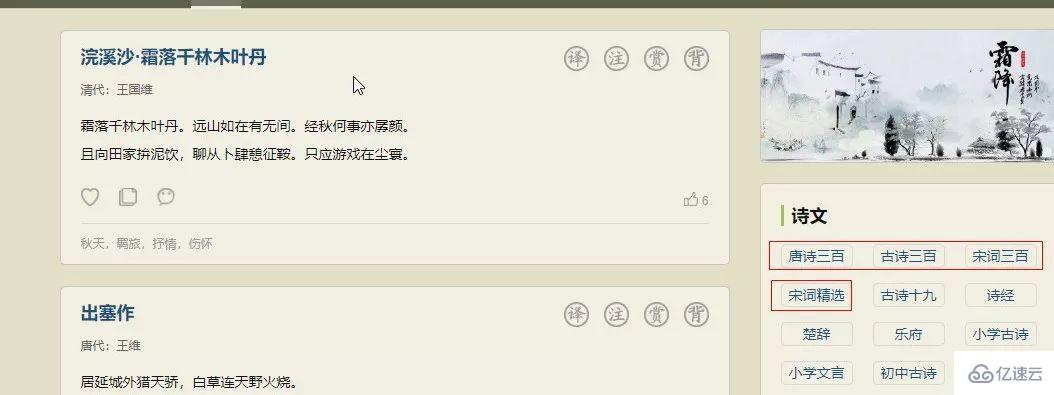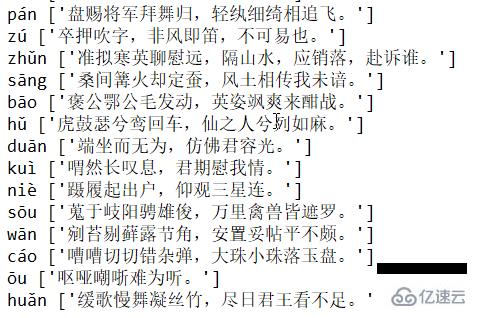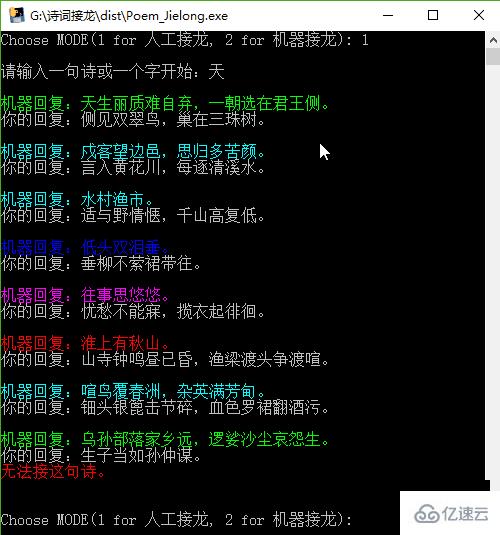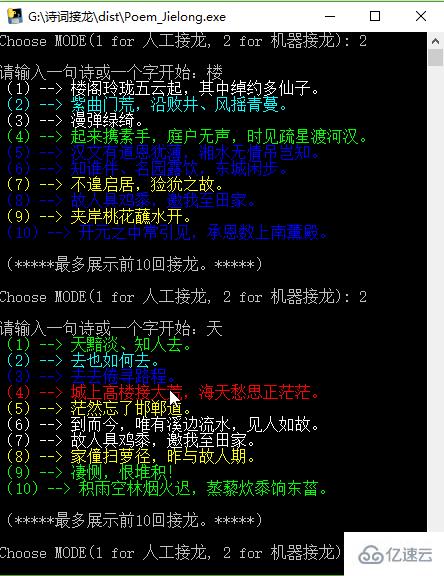您好,登錄后才能下訂單哦!
您好,登錄后才能下訂單哦!
這篇文章主要介紹“怎么使用Python編寫詩詞接龍程序”,在日常操作中,相信很多人在怎么使用Python編寫詩詞接龍程序問題上存在疑惑,小編查閱了各式資料,整理出簡單好用的操作方法,希望對大家解答”怎么使用Python編寫詩詞接龍程序”的疑惑有所幫助!接下來,請跟著小編一起來學習吧!
??首先,我們利用Python爬蟲來爬取詩歌,制作語料庫。爬取的頁面如下:

爬取的詩歌
由于本文主要為試了展示該項目的思路,因此,只爬取了該頁面中的唐詩三百首、古詩三百、宋詞三百、宋詞精選,一共大約1100多首詩歌。為了加速爬蟲,采用并發實現爬蟲,并保存到poem.txt文件。完整的Python程序如下:
import re
import requests
from bs4 import BeautifulSoup
from concurrent.futures import ThreadPoolExecutor, wait, ALL_COMPLETED
# 爬取的詩歌網址
urls = ['https://so.gushiwen.org/gushi/tangshi.aspx',
'https://so.gushiwen.org/gushi/sanbai.aspx',
'https://so.gushiwen.org/gushi/songsan.aspx',
'https://so.gushiwen.org/gushi/songci.aspx'
]
poem_links = []
# 詩歌的網址
for url in urls:
# 請求頭部
headers = {: 'Mozilla/5.0 (Windows NT 10.0; WOW64) AppleWebKit/537.36 (KHTML, like Gecko) Chrome/67.0.3396.87 Safari/537.36'}
req = requests.get(url, headers=headers)
soup = BeautifulSoup(req.text, "lxml")
content = soup.find_all('div', class_="sons")[0]
links = content.find_all('a')
for link in links:
poem_links.append('https://so.gushiwen.org'+link['href'])
poem_list = []
# 爬取詩歌頁面
def get_poem(url):
#url = 'https://so.gushiwen.org/shiwenv_45c396367f59.aspx'
# 請求頭部
headers = {: 'Mozilla/5.0 (Windows NT 10.0; WOW64) AppleWebKit/537.36 (KHTML, like Gecko) Chrome/67.0.3396.87 Safari/537.36'}
req = requests.get(url, headers=headers)
soup = BeautifulSoup(req.text, "lxml")
poem = soup.find('div', class_='contson').text.strip()
poem = poem.replace(' ', '')
poem = re.sub(re.compile(r"([sS]*?)"), '', poem)
poem = re.sub(re.compile(r"([sS]*?)"), '', poem)
poem = re.sub(re.compile(r"。([sS]*?)"), '', poem)
poem = poem.replace('!', '!').replace('?', '?')
poem_list.append(poem)
# 利用并發爬取
executor = ThreadPoolExecutor(max_workers=10) # 可以自己調整max_workers,即線程的個數
# submit()的參數: 第一個為函數, 之后為該函數的傳入參數,允許有多個
future_tasks = [executor.submit(get_poem, url) for url in poem_links]
# 等待所有的線程完成,才進入后續的執行
wait(future_tasks, return_when=ALL_COMPLETED)
# 將爬取的詩句寫入txt文件
poems = list(set(poem_list))
poems = sorted(poems, key=lambda x:len(x))
for poem in poems:
poem = poem.replace('《','').replace('》','')
.replace(':', '').replace('“', '')
print(poem)
with open('F://poem.txt', 'a') as f:
f.write(poem)
f.write('
')該程序爬取了1100多首詩歌,并將詩歌保存至poem.txt文件,形成我們的詩歌語料庫。當然,這些詩歌并不能直接使用,需要清理數據,比如有些詩歌標點不規范,有些并不是詩歌,只是詩歌的序等等,這個過程需要人工操作,雖然稍顯麻煩,但為了后面的詩歌分句效果,也是值得的。
??有了詩歌語料庫,我們需要對詩歌進行分句,分句的標準為:按照結尾為。?!進行分句,這可以用正則表達式實現。之后,將分句好的詩歌寫成字典:鍵(key)為該句首字的拼音,值(value)為該拼音對應的詩句,并將字典保存為pickle文件。完整的Python代碼如下:
import re
import pickle
from xpinyin import Pinyin
from collections import defaultdict
def main():
with open('F://poem.txt', 'r') as f:
poems = f.readlines()
sents = []
for poem in poems:
parts = re.findall(r'[sS]*?[。?!]', poem.strip())
for part in parts:
if len(part) >= 5:
sents.append(part)
poem_dict = defaultdict(list)
for sent in sents:
print(part)
head = Pinyin().get_pinyin(sent, tone_marks='marks', splitter=' ').split()[0]
poem_dict[head].append(sent)
with open('./poemDict.pk', 'wb') as f:
pickle.dump(poem_dict, f)
main()我們可以看一下該pickle文件(poemDict.pk)的內容:

pickle文件的內容(部分)
當然,一個拼音可以對應多個詩歌。
??讀取pickle文件,編寫程序,以exe文件形式運行該程序。 ?為了能夠在編譯形成exe文件的時候不出錯,我們需要改寫xpinyin模塊的init.py文件,將該文件的全部代碼復制至mypinyin.py,并將代碼中的下面這句代碼
data_path = os.path.join(os.path.dirname(os.path.abspath(__file__)), 'Mandarin.dat')
改寫為
data_path = os.path.join(os.getcwd(), 'Mandarin.dat')
這樣我們就完成了mypinyin.py文件。 ?接下來,我們需要編寫詩歌接龍的代碼(Poem_Jielong.py),完整代碼如下:
import pickle
from mypinyin import Pinyin
import random
import ctypes
STD_INPUT_HANDLE = -10
STD_OUTPUT_HANDLE = -11
STD_ERROR_HANDLE = -12
FOREGROUND_DARKWHITE = 0x07 # 暗白色
FOREGROUND_BLUE = 0x09 # 藍色
FOREGROUND_GREEN = 0x0a # 綠色
FOREGROUND_SKYBLUE = 0x0b # 天藍色
FOREGROUND_RED = 0x0c # 紅色
FOREGROUND_PINK = 0x0d # 粉紅色
FOREGROUND_YELLOW = 0x0e # 黃色
FOREGROUND_WHITE = 0x0f # 白色
std_out_handle = ctypes.windll.kernel32.GetStdHandle(STD_OUTPUT_HANDLE)
# 設置CMD文字顏色
def set_cmd_text_color(color, handle=std_out_handle):
Bool = ctypes.windll.kernel32.SetConsoleTextAttribute(handle, color)
return Bool
# 重置文字顏色為暗白色
def resetColor():
set_cmd_text_color(FOREGROUND_DARKWHITE)
# 在CMD中以指定顏色輸出文字
def cprint(mess, color):
color_dict = {
: FOREGROUND_BLUE,
: FOREGROUND_GREEN,
: FOREGROUND_SKYBLUE,
: FOREGROUND_RED,
: FOREGROUND_PINK,
: FOREGROUND_YELLOW,
: FOREGROUND_WHITE
}
set_cmd_text_color(color_dict[color])
print(mess)
resetColor()
color_list = ['藍色','綠色','天藍色','紅色','粉紅色','黃色','白色']
# 獲取字典
with open('./poemDict.pk', 'rb') as f:
poem_dict = pickle.load(f)
#for key, value in poem_dict.items():
#print(key, value)
MODE = str(input('Choose MODE(1 for 人工接龍, 2 for 機器接龍): '))
while True:
try:
if MODE == '1':
enter = str(input('
請輸入一句詩或一個字開始:'))
while enter != 'exit':
test = Pinyin().get_pinyin(enter, tone_marks='marks', splitter=' ')
tail = test.split()[-1]
if tail not in poem_dict.keys():
cprint('無法接這句詩。
', '紅色')
MODE = 0
break
else:
cprint('
機器回復:%s'%random.sample(poem_dict[tail], 1)[0], random.sample(color_list, 1)[0])
enter = str(input('你的回復:'))[:-1]
MODE = 0
if MODE == '2':
enter = input('
請輸入一句詩或一個字開始:')
for i in range(10):
test = Pinyin().get_pinyin(enter, tone_marks='marks', splitter=' ')
tail = test.split()[-1]
if tail not in poem_dict.keys():
cprint('------>無法接下去了啦...', '紅色')
MODE = 0
break
else:
answer = random.sample(poem_dict[tail], 1)[0]
cprint('(%d)--> %s' % (i+1, answer), random.sample(color_list, 1)[0])
enter = answer[:-1]
print('
(*****最多展示前10回接龍。*****)')
MODE = 0
except Exception as err:
print(err)
finally:
if MODE not in ['1','2']:
MODE = str(input('
Choose MODE(1 for 人工接龍, 2 for 機器接龍): '))現在整個項目的結構如下(Mandarin.dat文件從xpinyin模塊對應的文件夾下復制過來):

項目文件
切換至該文件夾,輸入以下命令即可生成exe文件:
pyinstaller -F Poem_jielong.py
生成的exe文件為Poem_jielong.exe,位于該文件夾的dist文件夾下。為了能夠讓exe成功運行,需要將poemDict.pk和Mandarin.dat文件復制到dist文件夾下。
??運行Poem_jielong.exe文件,頁面如下:

exe文件開始頁面
本項目的詩歌接龍有兩種模式,一種為人工接龍,就是你先輸入一句詩或一個字,然后就是計算機回復一句,你回復一句,負責詩歌接龍的規則;另一種模式為機器接龍,就是你先輸入一句詩或一個字,機器會自動輸出后面的接龍詩句(最多10個)。 ?先測試人工接龍模式:

人工接龍
??再測試機器接龍模式:

到此,關于“怎么使用Python編寫詩詞接龍程序”的學習就結束了,希望能夠解決大家的疑惑。理論與實踐的搭配能更好的幫助大家學習,快去試試吧!若想繼續學習更多相關知識,請繼續關注億速云網站,小編會繼續努力為大家帶來更多實用的文章!
免責聲明:本站發布的內容(圖片、視頻和文字)以原創、轉載和分享為主,文章觀點不代表本網站立場,如果涉及侵權請聯系站長郵箱:is@yisu.com進行舉報,并提供相關證據,一經查實,將立刻刪除涉嫌侵權內容。